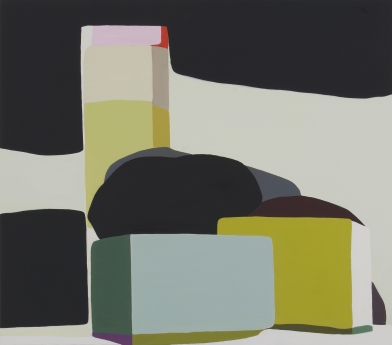.
"...the liminal spaces of perception"
What does "liminal" mean? I thought it has to do with light, illumination that provides perspective. Something elevated, spiritually pure, rational, intentional, unlike its scary opposite, subliminal, with its 50's brainwashing reverb, its paralysis of analytic insight.
Liminal, it turns out, is actually simpler:
liminal |ˈlimənl| adjective technical 1 relating to a transitional or initial stage of a process.2 occupying a position at, or on both sides of, a boundary or threshold. (New Oxford American Dictionary)
 |
| Louise Belcourt, Mound #8, 2015 |
 |
| Lamb's Ear #5, 2016 |
Belcourt’s paintings explore the intersections between the built and natural world. For her first show at Locks, the artist presents new oil paintings of architectural “mounds” in shifting spatial planes—what she calls “paintings of sculptures of landscapes... her paintings, which blend impressions of the countryside and crisp Canadian light with city rhythms and the blocky architecture of New York City. Belcourt’s imagery evokes forms from prehistoric “mound-builders” to urbanization, while creating a visual language distinct from a purely representational or abstract syntax. ..Using bold colors, radiant light, and dynamic perspectives, Belcourt’s images of tectonic landforms—stacked, occluded, and cascading into foreground and background—meld nature and man-made forms, reflecting an ecological awareness and heightened sensitivity to the world around usJuThe artist employs a directness, physicality, and visual clarity in her paintings that feels increasingly rare in our media-driven digital age. (from Locke Gallery website).
The writer comments that, despite the contemporary palette, the paintings have no references to digital culture. The painter and the paintings act as visual mediator, cleared of digital processing.
I guess that makes her a romantic, and possibly irrelevant to contemporary art. I think she's moving wonderfully in the formal issues of painted abstraction, still grounded in earthly splendor.
We could go for a walk in her paintings, the forms of nature reduced to mounds, meanders, and structures that shift the relation between self and world, like entering a well-proportioned home.
In painter Justin Margitich's new show, "A New Sublime" at Moskowitz Bayse, the artist seems to embrace digital forms, according to the gallery commentary. In the painting below, fluid ribbons struggle to escape the clinch of empty and connected "frames", (television screens, film frames?)
 |
Justin Margitich Iridium #3, 2014 Acrylic and colored pencil on paper 24 x 24 inches |
Justin Margitich meditates deeply on natural forms in a digital world. His paintings distill and fracture landscape, creating a formal language that challenges common perception of perspective and logical space. Margitich reconciles vanishing notions of idyllic landscape with our growing reliance on digital technology in a cohesive aesthetic act, creating a new sublime image. (from Moskowitz Bayse website)
 |
| Justin Margitich Variations 15, 2016 Acrylic, watercolor and paper on panel 30 x 22 inches |
 |
| Justin Margitich Derivation 3, 2016 Acrylic and graphite on panel 36 x 36 inches |
"Derivation #3" references light shafts, fractals, or perhaps rockets taking off? Shapes are juxtaposed, overlaid, interwoven. I mistrust myself when I find such narrative material in painting. I cringe because I think of all the artists I've heard explain that there's no there there.
And as Steven Alexander explains: discerning meaning in a painting is not the same as reading a narrative. To regard a painting simply as a text is to ignore the extreme complexity and the mystery of non-sequential interactions that take place in the inclusive realm of aesthetic experience. (from his blog post, 5-18-08, "Meaning and Abstract Painting")
And as Steven Alexander explains: discerning meaning in a painting is not the same as reading a narrative. To regard a painting simply as a text is to ignore the extreme complexity and the mystery of non-sequential interactions that take place in the inclusive realm of aesthetic experience. (from his blog post, 5-18-08, "Meaning and Abstract Painting")
Just the casual viewer puzzling through his abstraction encounter, making a guessing game out of enigmatic figure/ground relations. Not that it's the painter's fault, it seems more a failure of my own perception here.
Margitich's agenda is formidable - to explore the digital sublime, and resolve it in painting. To me, his paintings remain cool and aloof,incomplete passes at a goal worthy of further attempts.